Named (& sometimes dated)
buildings
See our Warwick Road page (last passage) for notes
on house-naming and house-numbering.
California Estate
The whole area to the east of Belle Vue
Road was nicknamed California (our Rosehill
case study covers more of its history). The
development there started in the
early days of the Ipswich &
Suffolk Freehold Land Society (F.L.S.) (which became Ipswich Building Society)
formed in
1849: the year of the Californa gold rush.
There seems to have been a real 'frontier' feel to the area in the
early days: tenants raised livestock, dug stone, gravel and brickearth,
made
bricks, market gardened and made a small living in many ways from the
sizeable
plots around their modest cottages.
One or two of those early semi-detached houses,
standing well back from the highway still exist, often built around by
later dwellings.
Felixstowe Road
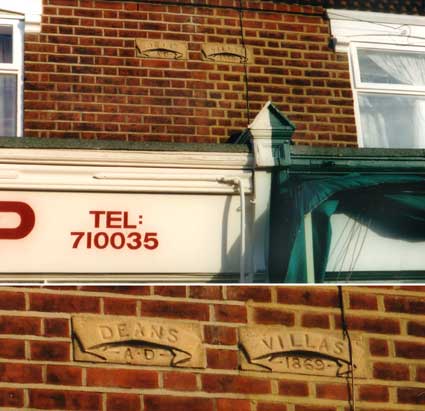
The widespread evidence of the involvement of the
Ipswich and Suffolk Freehold
Land Society is provided by these rather grand scrolled name plaques.
This
is:
'DEANS ... VILLAS
A.D. ... 1869'
above the shop fronts at 113 Felixstowe
Road.
The designs of the scrolls are quite varied.
Nelson Road
Although Admiral Lord Nelson, born in Burnham Thorpe,
Norfolk, died in 1805 – long before this road was laid out – he was
linked to this area of Ipswich; see Street
name derivations.
Below: three examples of rather more florid scrolled
signs from
the Spring Road end of Nelson Road:
'GLYDE COTTAGE'S
1870'
WHITEHTHORN COTTAGE'S
1869'
NELSON'S COTTAGE'S
1870'
The first may well be
named after social historian and antiquary of Ipswich, John Glyde
(1823–1905) – the 'G' which looks more like a 'C' is seen in other
signs around this period. The first is also notable for
the stray 'greengrocer's apostrophe' in "Cottage's"– unless it's damage
to the plaster.
The second and third have a sizeable
space between the 'E' and 'S' to the right. And "Nelson's Cottages" has
a possessive apostrophe.
 2016
images
2016
images
[UPDATE 17.3.2020: It
was much later that we noticed a similar scrolled plaque round the
corner and nearer to Spring Road (but still in Nelson Road). The depth
of the moulding is very clear here, emphasised by the painted and
indented characters following the contours.]
'LYDIA COTTAGES
1868'
 2020
image
2020
image
These parts of Nelson Road were developed by The Ipswich & Suffolk Freehold Land Society
and the named scroll is used elswhere on FLS houses in IpswichRegent Terrace 1875 J.J. Head.
BuilderRegent Terrace 1875 J.J. Head.
BuilderRegent Terrace 1875 J.J. Head.
Builder; some examples are shown on this
page.
Clarence House on St Margaret's Green (Thingstead)
has an unusual asymmetric scrolled name plaque. See our Roundwood Road page for more on Nelson
and his connection to Ipswich.
Hill House

 2017
images
2017
images
'HILL HOUSE, 1863'
Nearby, 52 Nelson Road,
stands opposite the jaws of Tovells
Road and is the earlier house in this street. Long shrouded by
vegetation, in January 2016 the frontage of this house and its
lettering were revealed. The Borough's Local list describes Hill House:
'A two storey red brick house with white brick quoins. A 3 window range
on the first floor and 2 window range on the ground floor all with 12
light sash windows. Built in 1863 as a farm house, the terraced houses
adjacent were built for farm workers.'
See our Vicarage Woodbridge Road
page for an 1884 map of Nelson Road.
Marlborough House
83 Tomline Road is the site of this an unusual (for Tomline Road),
double-fronted house set at 90-degrees-to-the-road. It
cannot easily be seen from the ground which poses a question. This
lettering is so high up Paul Smith, to whom our thanks, spotted it
while cycling northwards up Derby Road towards the bridge over the
railway.
'MARLBOROUGH HOUSE. 1891.'

 2020
images courtesy Paul Smith
2020
images courtesy Paul Smith
Incidentally, another double-fronted Victorian house with
lettering running round the arch can be found at the other end of
Tomline Road (no. 4): 'IVY ... HOUSE':

47-9 Henslow Cottages
Further up Nelson Road towards the Woodbridge Road is a terrace
bearing the plaque:
'HENSLOW
COTTAGES
1899'

 2016
images
2016
images
This is an interesting attribution, and compares with 'Henslow
Terrace, 1868' at the beginning of Henley Road (see below). The Henslow
Terrace name is in a more logical
geographical position, being sited close to the Ipswich
Museum, of which institution Charles
Darwin's
mentor (there's also a Darwin Road), Rev. John Stevens Henslow, was the
second president. So why does the
name crop up thirty-one years later – and a mile-and-a-half away – in
Nelson Road? There is another Henslow Terrace in –
guess where? – Henslow Road on the California
Estate (see below).
Henslow
Terrace, 1 Henley
Road
 2013 image
2013 image
'HENSLOW
TERRACE
1868'
Named, seven year's after his
death, after John Stevens Henslow:
mentor of Charles Darwin, geologist and
second President of the nearby
Ipswich Museum. Not only did this
good-natured academic and clergyman teach Darwin much of his scientific
technique, but he also arranged a place for his favourite pupil aboard
HMS Beagle during whose voyages, Darwin's observations and collecting
laid the foundation for the eventual publication of his revolutionary On the origin of species. During
the Beagle voyage, Darwin and Henslow corresponded as often as the
primitive postal system would allow. Henslow became the main recipient
of Darwin's massive collection of scientific samples, despatched home
at irregular intervals during the voyage. He saw to it that these
samples were passed on to the appropriate experts for analysis, and
took it upon himself to publish extracts of Darwin's letters in
respectable scientific journals. By the time Darwin returned home in
1836, his scientific credentials and future scientific career were
assured - largely thanks to Henslow. The year following Darwin's return
to England, Henslow secured the rectorship of the neglected parish of
Hitcham in Suffolk, where he was to remain for the rest of his life.
Surprisingly perhaps, the great university lecturer made only a
mediocre preacher. His first congregation in Hitcham Church was not big
enough to fill a single pew. He decided to concentrate, therefore, on
improving the well-being of his parisioners through scientific, rather
than spiritual, enlightenment. He encouraged local farmers to take part
in experiments into crop diseases and fertilisers (derived from
coprolites: the industry founded by Edward Packard at the 'Manure
Manufactory' which stood at the Wet Dock on Coprolite Street – clearly
shown on the 1881 map on our Steam
Packet Inn page). Indeed,
two farmers he met while on holiday in Felixstowe were so impressed
with his advice that they set up their own fertiliser company: Fisons.
He founded a village school (giving some of the lessons himself) and
was one of the founders of the Ipswich Museum; he administered local
charities, introduced garden allotments for parishioners, and organised
educational excursions to various venues, including the 1851 Great
Exhibition.
Henslow's activities did not, however, become entirely parochial: he
still found time to carry out archaeological excavations, tutor Queen
Victoria's children, and keep in touch with the wider scientific
community, including his celebrated former pupil, Mr Charles Darwin,
Fellow of the Royal Society. Indeed, in 1860, the year before his
death, Henslow chaired the legendary Oxford meeting of the British
Association for the Advancement of Science, in which Thomas Henry
Huxley and Henslow's son-in-law, Joseph Dalton Hooker, crossed swords
with Bishop 'Soapy Sam' Wilberforce over the subject of Darwin's On the origin of species. "I fully believe a better man never walked this earth." — Charles Darwin to J.D. Hooker, 18th May,
1861, the day of Henslow's death.
Ipswich is twelve miles from Hitcham. As a result of his Cambridge
experiences, Henslow believed in the value of museums as vehicles for
education. The museum at Ipswich, which was established in Museum
Street in 1847, owed much to Henslow, who was elected President in
1850. The museum was based on natural history, construed in the
broadest sense. A conflict between the Curator, a Dr Clarke, and the
"vile and disorderly mob that contaminates our room on public nights"
with their "obscene conversations [and] indelicate and blasphemous
retorts" reminds us that delivering education to the people can be a
challenging undertaking.
[UPDATE 22.6.2020: we noticed a
while ago that a new, second plaque bearing the same inscription had
been mounted on the second house in this four-house terrace.]


As well as the named building 'Henslow
Cottages 1899' (47/9 Nelson
Road, shown above), there is another Henslow Terrace in –
guess where?
– Henslow Road on the California Estate.
Henslow Terrace, 119-121 Henslow Road

 2021
images
2021
images
'HENSLOW
F.L.S 1902
TERRACE'
Above: the cartouche with triple frame between 119 and 121
Henslow Road has had its middle line filled with a white material,
which only serves to highlight the date and attribution. The quite
eccentric
capitals are of interest in that the curving words above and below
don't follow the baselines of the characters, rather they maintain the
uprights and each letter is morphed into the curve. Curlicues
can be made out above and below the middle line.

Above: the Henslow Road street nameplate on the corner of
Freehold Road. As we can see, John Stevens Henslow is celebrated in
several places in Ipswich; see Street name
derivations.
And it's only right to include the two companion pieces to
Henslow Terrace...


'CLEVELAND
F.L.S 1903
TERRACE'
Cleveland is a land of hills and
dales from the River Tees to Vale of Pickering, Yorkshire.


'ROTHESAY
F.L.S 1904
TERRACE'
Rothesay is the principal town on
the Isle of Bute, in the council area of Argyll and Bute, Scotland.
One terrace per year was built by the Freehold Land
Society at the Foxhall Road end of Henslow Road.

14 Crabbe Street
Another even more florid example of a Freehold Land
Society property, carefully
tended by the owners:
'PERCY
COTTAGES'
(sadly no date, but 1860s/1870s
is
most likely).
 2013 image
2013 image
The 2013 image above shows that the lettering on Percy Cottages
has been whitewashed over. Compare with other scrolled house names at York Terrace and Clarence
House.
 2013 images
2013 images
29 Crabbe Street
This is a rather stylish way to name one's house, a colourful stained
glass door panel. Wonder what it looks like from inside. High up on the
gable appears a date: probably hand-done by a builder?
'KENMORE
1902'

41 Crabbe Street:
the name that never was.


This flint and brick-built detached house stands back from the
road and bears an unusual scrolled shield name-plaque in the gable
which
is blank. It is quite common to find name tablets and cartouches with
no lettering on houses, but this one is particularly decorative and,
ultimately, pointless. Some house-owners have gone to
the expense of having the house name plaque removed from the fabric of
the building, to be replaced by bricks; see our Rosehill house names page for an
example. They must have really hated
that name.
Aldeburgh Gardens
And just to show that current builders and developers will, on
occasion, build names into structures, here is the entrance to
Aldeburgh Gardens in Crabbe Street. Nice ball finials, chaps.

 Photo
courtesy John Norman (2014)
Photo
courtesy John Norman (2014)
Coronation Cottages, 69-71 Levington
Road (and street nameplate)
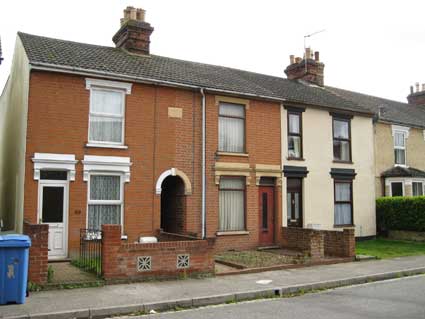
 2013
images
2013
images
'CORONATION
1902
COTTAGES'
Edward VII (Albert Edward, 9 November 1841 – 6 May 1910) was
King of the United Kingdom and the British Dominions and Emperor of
India from 22 January 1901 until his death in 1910. The eldest son of
Queen Victoria and Prince Albert of Saxe-Coburg and Gotha, Edward was
related to royalty throughout Europe. Before his accession to the
throne, he served as heir apparent and held the title of Prince of
Wales for longer than any of his predecessors. During the long reign of
his mother, he was largely excluded from political power and came to
personify the fashionable, leisured elite. He travelled throughout
Britain performing ceremonial public duties and represented Britain on
visits abroad. His tours of North America in 1860 and the Indian
subcontinent in 1875 were popular successes, but his reputation as a
playboy prince soured his relationship with his mother. On January 22,
1901 Queen Victoria died and Edward VII began his reign. However the
actual coronation as celebrated in this plaque took a while to occur.
A royal tour by Edward and Alexandra and the long drawn-out war
in
South Africa further delayed plans for his coronation. By the 24 June
King Edward VII, who was suffering from perityphlitis, required urgent
surgery. Consequently, the coronation, for which unprecedented
preparations had been made, was postponed. The King recovered his
strength quickly after the operation and it was decided that the
coronation service would be held on August 9, 1902. With minimal
fanfare, the coronation finally took place at Westminster Abbey.
However, the King still recovering from his illness, waited several
months before participating in a royal procession through the main
streets of South London. When his procession did take place on October
25 1902 the King was received with great enthusiasm by the people
lining the streets. For more extensive notes on the royal couple, see Alexandra Park.
 2019
image
2019
image
[UPDATE 4.2.2019: Simon
Bole sent this photograph: 'Have you noticed a new style of nameplates?
This went up a couple of weeks ago apparently.' Thanks to Simon; they look as if they cost
a bit more than the standard rectangle (with or without the Borough coat of arms). We hope they don’t fade as badly as the
rectangular ones, some of which now boast a white space where the coat
of arms has faded in the sun. March
2021: this format of street nameplate is becoming widely used in
the town to replace damaged or faded plates, probably dating to the
1970s/1980s.]
Beaufort Buildings, 133 Norwich Road
Now a departure. There are many examples of house names
on pillars and
plaques
in the town, but
'BEAUFORT BUILDINGS'
at 133 Norwich Road takes pride
of
place, if only for its scale and unreadability. Easily mistaken for
'Branfort
Buildings', the spidery, gothic lettering painted in this specially
recessed
white
rectangle above the two front porches doesn't quite do the job for
which
it is intended.
 2001 image
2001 image
Thornley Place, Waterloo Road

'THORNLEY
PLACE.'
on the corner of Chevallier Street and Waterloo Road has a name
plaque you can't miss. We assumed that it is named after Felix Thornley
Cobbold (great benefactor to Ipswich – see
our Blue
plaques page), as
he was the son of John Chevallier, after whom this stretch of the main
road was named. However, it's more likely that the road
was named after Dr Barrington Chevallier (see Street name derivations); the
'Thornley' may be just a coincidence, but Dr Chevallier certainly
appears on the Cobbold Family History Trust
family trees.
[UPDATE 19.4.13: Anthony
Cobbold of the Cobbold Family History Trust (see Links)
writes: "I don’t feel able to add anything specific on Thornley Place,
but I can suggest how the Thornley name arrived in Suffolk. If
you go to John Chevallier Cobbold #114 on the tree you find him married
to Lucy Patteson #115. Lucy’s maternal grandmother was Hannah
Thornley #1315, daughter of Robert #1319. The Thornleys were a
well-to-do family from Cheshire and one source tells me that Hannah
inherited Eaton Hall in Cheshire which I think is now the centre of the
Duke of Westminster’s Grosvenor Estates. In naming Felix, it is
quite likely that Lucy wanted her grandmother’s family to be
recalled. But this is only a suggestion." Thanks to Anthony for the additional
information on this.]
However, there was a school in Norwich Road called Thornley
House School which ran from at least the 1940s until it closed in
1966. One wonders if there is a connection between the school's name
and the nearby Thornley Place?
32 Queen Street
 2013 image
2013 image
'THIRTY
TWO'
A deco-style entrance door to
number 32 Queen Street, with the building number spelt outin relief in
Gill Sans (or similar) font between two discs.
Commerce Chambers, 12 High Street

 2014
images
2014
images
The art deco buildings at the corner of Tower
Ramparts and Museum Street with a name panel above a very modest door
which has seen much better days:
'COMMERCE
CHAMBERS'
Telolmakouta House, 2 Surbiton Road

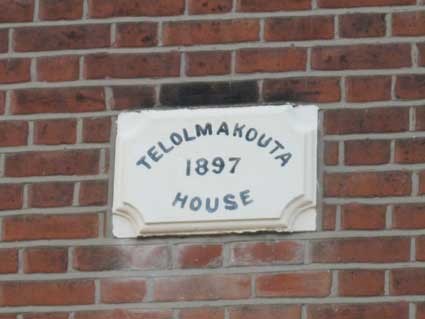
'TELOLMAKOUTA
HOUSE
1897'
What a mysterious name... So far
we haven't found any source for this African-sounding word, perhaps
related to the Boer War? Just out of
curiosity:-
The Tălmăcuța River is a tributary of the Lungşoara River in Romania.
Makuta is a village in central Malawi on Lake Malawi, Africa. It
is located in Salima District in the Central Region approximately 1
mile north of Nkhotakota.
Makuta is a village in Central District of Botswana, Africa. It
is located 70 km north-west of Francistown, along the road connecting
Francistown to Tutume.
[UPDATE
1.2.2024: 'Do you think it's possible that TELOLMAKOUTA (Bramford Road)
is a misspelling of TELL EL-MASKHUTA. Here's the link;
the artefacts found were exhibited in London in 1905 so maybe the house
has a link with when the [discoveries were made]? Best wishes, Marion
Little.' Many thanks to Marion for
this quite persuasive derivation of the name, whic has links still to
Africa, but to the far north-east in Egypt. One additional piece of
evidence is that Tell-El-Maskhuta is a few miles west of Zagazig,
commemorated in the house name opposite (no. 256 Bramford Road), as is
Tel El Kebir on no. 360 – a few hundred yards down on the same side of
Bramford Road.]
See our Bramford Road page for
interesting house name plaques on neighbouring buildings.
Le-Treport, 1 Palmerston Road
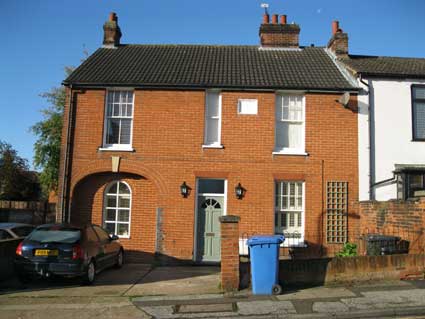

'LE-TREPORT
1923'
1 Palmerston Road is a distance up the slope from the St Helens
Street junction; in fact, it stands opposite the jaws of Lancaster Road. Palmerston Road was once
on the outskirts of the town, however these buildings must have been a
late addition given the huge expansion of Ipswich & Suffolk
Freehold Land Society housing from Albion Hill eastwards in the 1890s.
Until a few years ago,
this end-of terrace house suggested that it was a place of trade as
well as a dwelling. The arch to the left was a carriage entrance to a
rear yard; it has been converted into part of the house now. The house
name is one of several intriguing name plaques in the town and the
source of the name seems to be: Le Tréport (no hyphen and an acute
accent), a commune in the Seine-Maritime department in the
Haute-Normandie region in northern France. A small
fishing port and light industrial town situated in the Pays de Caux.
The mouth of the Bresle river meets the English Channel here, in
between the high chalk cliffs and the pebbly beach. Le Tréport is also
a sea-side resort and home to a casino. Perhaps the builder went there
for his holiday.
12-14 Spring Road
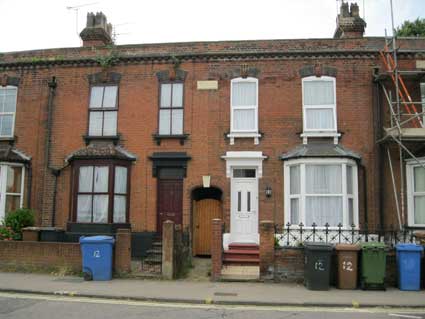
 2014 images
This long, six-house terrace close to the junction with Grove
Lane bears
the incribed plaque:
2014 images
This long, six-house terrace close to the junction with Grove
Lane bears
the incribed plaque:
'CONGRESS
TERRACE
1878 . W.G'
Presumably the 'W.G' relates to
the initials of the house-builder?
"Another venture of the Society (F.L.S.)
was the purchase of houses which could be let at an annual rent. An
interesting example of this is the purchase of Congress Terrace, Spring
Road, 1880. Numbers 3 and 4 cost £280 each, the other four £275 each.
Numbers 3 and 4 would be let at an annual rent of £17 10 shillings, the
others at £16 10 shillings. They were to be ballotted for." (Clegg, M: The way we went, see Reading list).

 2014 images
2014 images
8-10 Nottidge Road:
'WOODBINE
COTTAGES
1868'

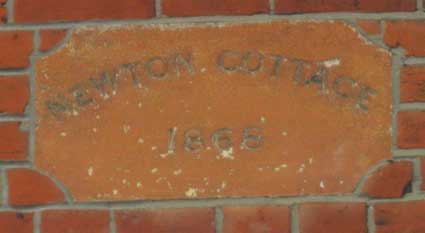 14-16 Nottidge Road:
14-16 Nottidge Road:
'NEWTON COTTAGE
1868'
The top line of these cartouche-shaped name plaques is a
pleasing
arc over the remainder. The unusual terra cotta-coloured paint on the
lower example is starting
to degrade with cream-white flecks showing through.
14 Bartholomew Street
1.8.2024: 'My friend pointed out to me that I should
let you know about the lettering on my house , 14 Bartholomew
Street IP4 . It is a semi detached Victorian house and we are
called Pekahaih Cottages 1864. I will attach a photo. Fiona Howard.' Thanks to Fiona for sending this unusual
example.
 Image courtesy Fiona Howard
Image courtesy Fiona Howard
'PEKAHAIH
COTTAGES
1864'
So where does this extraordinary name come from? It could be a transposition of
letters... Pekahiah (translated
as Yahu
has opened [the eyes]) was King of Israel 741-740 BC. ‘Pekahaih’
– as it appears on the name plaque – does not comeup in web searches.
The spelling
‘Pekahiah’ does, perhaps, ring truer: as in the ending of ‘Isaiah’.
It’s not unknown for Victorian builders commissioning house plaques
under pressure to make the occasional mistake, particularly in the
case of non-English words (see also 'Telolmakouta House, above). Why
did they choose an obscure name? Perhaps
they’d run out of flowers, trees, girl’s Christian names, famous
battles etc. Incidentally, this house was part of an early Ipswich
& Suffolk Freehold Land Society development, but we're surprised at
the date. Lancaster Road is a short
street running between Palmerston and Warwick Roads. It is of interest
because the houses in it were reputed to be the first to be built in
Ipswich by the
Freehold Land Society in 1866. Could it be that the final house in
Bartholomew Street was completed in 1866?
Christchurch Street
31-33 Christchurch Street bears the plaque:
'SANTIAGO
VILLAS
1870'

 2014
images
Santiago (population 5 million) is best known as the capital
city of Chile in South America. Santiago is named after the biblical
figure James, son of Zebedee (Sant Iago: Saint Iacob: Saint Jacob:
Saint James). It is uncertain whether this house name was applied in
1870 because of some particular event in Santiago but it is interesting
that, as part of the work of European landscapers, in 1873
O'Higgins Park came to existence in the centre of the city. Another
well-known place of the same name is Santiago de Compostela, the
capital of the autonomous community of Galicia in northwestern Spain;
the shrine of Saint James the Great, now the city's cathedral, as
destination of the Way of St. James, a leading Catholic pilgrimage
route. Etymologically, Santiago has the same meaning as
San Diego. This plaque is directly opposite Prospect
House, the former off licence.
2014
images
Santiago (population 5 million) is best known as the capital
city of Chile in South America. Santiago is named after the biblical
figure James, son of Zebedee (Sant Iago: Saint Iacob: Saint Jacob:
Saint James). It is uncertain whether this house name was applied in
1870 because of some particular event in Santiago but it is interesting
that, as part of the work of European landscapers, in 1873
O'Higgins Park came to existence in the centre of the city. Another
well-known place of the same name is Santiago de Compostela, the
capital of the autonomous community of Galicia in northwestern Spain;
the shrine of Saint James the Great, now the city's cathedral, as
destination of the Way of St. James, a leading Catholic pilgrimage
route. Etymologically, Santiago has the same meaning as
San Diego. This plaque is directly opposite Prospect
House, the former off licence.
28 Christchurch Street has an impressive porch with pillars,
strictly-speaking, half-columns:
'DORIC HOUSE'

 The Doric order: in their original Greek version, Doric columns
stood directly on the flat pavement, the stylobate, of a temple without
a base; their vertical shafts were fluted with 20 parallel concave
grooves; and they were topped by a smooth capital that flared from the
column to meet a square abacus at the intersection with the horizontal
beam, the architrave, that they carried. The Parthenon in Athens has
Doric columns. (See also Doric Place in Woodbridge; derivation not
known.)
The Doric order: in their original Greek version, Doric columns
stood directly on the flat pavement, the stylobate, of a temple without
a base; their vertical shafts were fluted with 20 parallel concave
grooves; and they were topped by a smooth capital that flared from the
column to meet a square abacus at the intersection with the horizontal
beam, the architrave, that they carried. The Parthenon in Athens has
Doric columns. (See also Doric Place in Woodbridge; derivation not
known.)
The house next door bears a street nameplate, shown in the image above
left (above the parked vehicle) which in 2014 is in urgent need of
repainting.
Jubilee Bakery, 55 Station Street


'JUBILEE BAKERY
G.D.G.
1887'
Simon Knott (Simon's Suffolk Churches see Links)
spotted this one. This is the corner shop some way up the Station Street slope and on the corner of Webb
Street. It bears comparison with 'Grove Bakery' in St Helens Street. In 1887 the United
Kingdom and the British Empire celebrated Queen Victoria's Golden
Jubilee. Victoria marked 20 June 1887—the fiftieth anniversary of her
accession—with a banquet, to which fifty European kings and princes
were invited. Although she could not have been aware of it, there was a
plan by Irish Republicans to blow up Westminster Abbey while the Queen
attended a service of thanksgiving. This assassination attempt, when it
was discovered, became known as the Jubilee Plot. At the time, Victoria
was an extremely popular monarch who went on to reign for 63 years,
seven months and two days (Victoria was the longest-reigning British
monarch and the longest-reigning queen regnant in world history) until
her death in 1901. However, since 5 February 2015, those titles were
assumed by Queen Elizabeth II.
'G.D.G.' is probably the
initials of the builder/developer.
See also the following example; also Nethaniah
Almshouses further up this thoroughfare.
Record Reign, 56 Rectory Road
The long Victorian enabled unprecedented house building in many parts
of the country, particularly around industrial centres. Ipswich was no
exception and the house-naming inevitably reflects landmarks in
Victoria's reign. So 'Jubilee Bakery 1887' (above) can be seen
alongside 'Long Reign' (undated, presumably celebrating Queen
Victoria's Golden Jubilee in 1887.) in Bramford
Road and this example, not far from the bakery.
 2020 image
2020 image
'RECORD REIGN.
1897
VILLA'
On 23 September 1896 Victoria surpassed her grandfather, George
III, as the longest reigning monarch in British history. The Queen
requested that any special celebrations be delayed until 1897, to
coincide with her Diamond Jubilee (60 years since she had become
Queen). Just into the new century came 'Coronation Cottages 1902' in
Levington Road (example shown
above).
Devonshire Terrace, 48-50 Philip Road

 2020 images
2020 images
'DEVONSHIRE
TERRACE
F.L.S. 1898'
Here is an example of Freehold Land Society housing in Over Stoke;
moreover, it is the largest cartouche plaque we have found in Ipswich
(six brick courses deep).
Industrial Villa, 33-35 Dillwyn Street

'INDUSTRIAL
VILLA
1870'
Perhaps the ultimate, bald, bleak name for a home (or group of
homes) in Dillwyn Street (see streets named after Slavery abolitionists). As we see
elsewhere, house and building names sometimes resonate with
significance, or are just pleasant. This one stands out in Ipswich. One
wonders if 'Industrial Villa' might relate to the St Matthew's
Industrial Home for Girls set up by Samuel Belcher Chapman (see the
'Chapman Lane' entry in Street name
derivations), but there is no evidence of this.
Plantation House, 11-13 Burlington Road
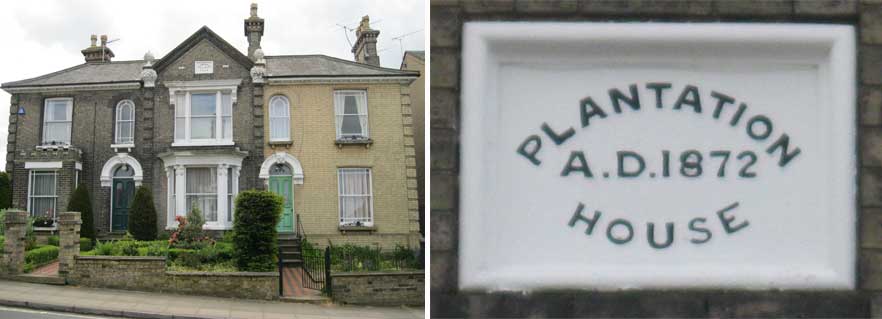
'PLANTATION
A.D.1872
HOUSE'
A grand, asymmetrical semi. There are different male heads
(Dickens and Shakespeare, confirmed by Dr John Blatchly) on the
keystones of the curved front door
arches of the two houses. It was designed by R.T. Orr.
The smaller house to the right was, perhaps, intended for the servants
of the
inhabitants next door. For more on the original inhabitants of this
house see John Talbot on our page about The
Unicorn.

The capitals on either side
of the gable, their mouldings differing in design, are worth a look,
too:

Plantation House is visible to
the left in the photograph below. The road opposite is
Stevenson Road. A possible source for this road name (and for nearby
Dalton Road) is given on our Slavery
abolitionists page with an 1867 map.
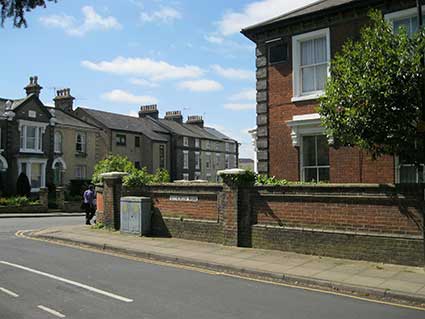
 2015 images
2015 images
Hollanden House, 9 Burlington Road
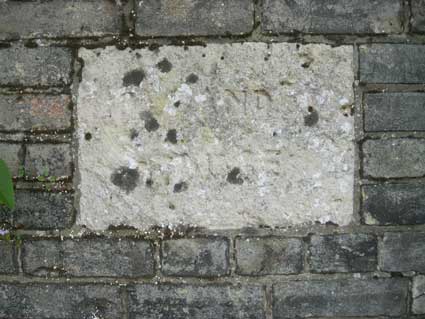
 2014 images
2014 images
The eroded stone block next to the postal wall
box at No. 9 has misleading shadows and
algae. 'Holland House'?... [UPDATE
19.8.2014:
" 'HOLLANDEN HOUSE' is the full text of the plaque on No 9.
Best wishes,
John Blatchly. Our thanks to John;
'Holland House' never seemed quite right.]
Paget Villas, 4 Paget Road
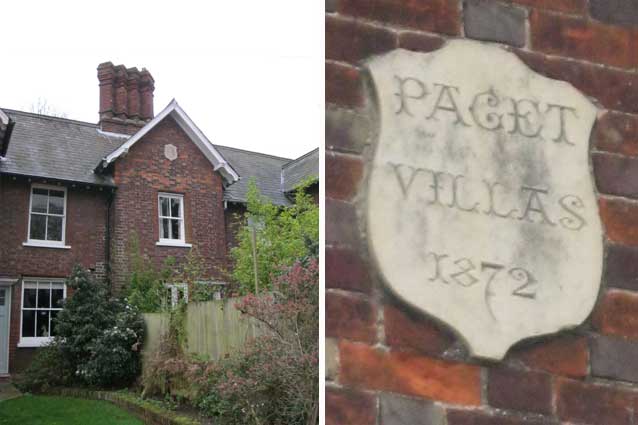 2014 images
2014 images
A remarkably decorative letterform here, with curlicues and a blissful
flourish on the downstroke of the '7'. All packaged in a shield-shaped
tablet, giving a faux-medieval feel:
'PAGET
VILLAS
1872'
Salisbury Terrace, 375-7 Woodbridge Road
 Photographs
courtesy Steve Girling
Photographs
courtesy Steve Girling


'SALISBURY
TERRACE
1899'
'Thought these photos may be of interest to you, they are of a
house nameplate on a house where I used to live along Woodbridge Rd
near the junction with Khartoum Rd.
Nearly 30 years ago I thought the stone with the name of the terrace on
it was coming away from the wall, but on closer inspection (on a ladder
!) I discovered that "SALISBURY TERRACE 1899 " was not in fact stone
but wood ! And what I thought was stone coming away from the wall was
paint lifting away from the wood so it was duly primed, undercoated and
gloss painted and it's still there today.
In some paperwork for the house there is a Conveyance dated 25th March
1898 between Edward Fison and William Grayston. Kind regards, Steve
Girling.' Thanks to Steve for this
unexpected architectural feature – they must have forgotten to
incorporate the 'stone' plaque when they built the wall.
'Tumbricane', 66 Belstead Road

 2016 images
2016 images
One brick pillar with grand white capstone to the south-west and no
fewer
than three to the nort-east mark this thought-provokingly named house.
In
itself, perhaps the building is not that special, but almost everyone
who travels down
Belstead Road knows 'TUMBRICANE'. The following
contribution explains the name.
[UPDATE 27.4.2017: ‘Our
property is Tumbricane on Belstead Road. The house number is 66.
There is no number 64 on the road.
After extensive research, we have arrived at the conclusion that the
property was named after a castle ruin in the architect’s place of
birth in County Tipperary in Ireland. There is a village called
Borrisokane, where outside is situated a castle ruin named
Tumbricane. As the architect and owner hailed from this village,
we consider this the most likely origin for the name.
This is not the original property. Our home was built during the
1920s, but the original Tumbricane, of which the gate, driveway and
pillars are original, was built during the 1890s, and we believe a
catastrophic event must have occurred for it to have disappeared by the
First World War. It was a vast grand mansion, of which I have
photographs, and we cannot understand why it only stood for a maximum
of twenty years. This is the next step in my research.
Many thanks and kind regards, Louise.’ Our grateful thanks to Louise for solving
this little mystery and for
the story and image of the house.]
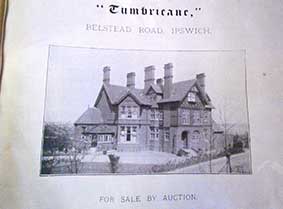

Above photograph courtesy Louise
What a fine mansion it was. Its footprint was much bigger than that of
the existing house.
'Grindlewald', 338 Felixstowe Road

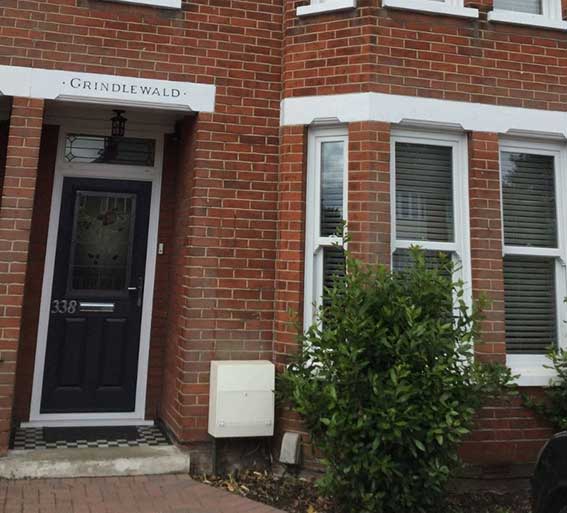 Photographs courtesy of Tim Butler
Photographs courtesy of Tim Butler
'I thought you may be interested in the attached pictures. I have
recently renovated a property in Felixstowe Rd and on stripping back
the paint on the door lintel, I found the original house name of
Grindlewald. The house was built in circa 1926 and is next door to my
own property, which has the original name of Havenside. I am not sure
as to how the property came to receive the name of a Swiss village
(prior to Harry Potter), but my house name is no doubt due to the
proximity of the Haven Public House- which was almost next door.
There is no reference to the house names in the deeds to the properties
that I have found. The builder of the properties was Frank Cadge, (I
have a manhole cover with his name on), and he purchased the land from
Ernest George Pretyman, owner of the Orwell Park. The land formed part
of the Ipswich Horse Racing circuit which bordered Nacton Rd, Lindbergh
Rd, Felixstowe Rd and Hatfield Rd. Regards Tim Butler.' Many thanks to Tim for sending the
photographs of the house name and named manhole cover.

'F. CADGE
BUILDER
IPSWICH'
Similarly named covers by local
builders can be found on our Street
furniture page (under 'More ground
level').
For more information about the Ipswich Horse Racing circuit see
our Racecourse Recreation Ground page.
Newark Lodge, 1 Anglesea Road
22.7.2020, from Alan Forsdyke: 'The road name "my end" of Anglesea Road
was replaced this week. Removing the old sign revealed the former house
name and the technicians sensibly fitted the new sign below so ‘NEWARK
LODGE’ can be seen. I thought you'd like to know. Dick Mainwaring who
lives there posted this photo on Facebook.' Alan previously sent the
photographs of the removal of the K6 phone
box immediately round this corner, outside The Greyhound public
house. Thanks to him for sending us the photograph and to Dick
Mainwaring for taking it.
 2020 image
2020 image
 pre-2020 image
pre-2020 image
The white panel painted on the brickwork bears neat, slightly condensed
capitals in black, presumably by a sign-writer. The replacement street
nameplate, incorporating the Borough crest in the curved top, is
similar to those seen in Eagle Street
and Levington Road.
Zippor Cottages, 33-35 Pearce Road
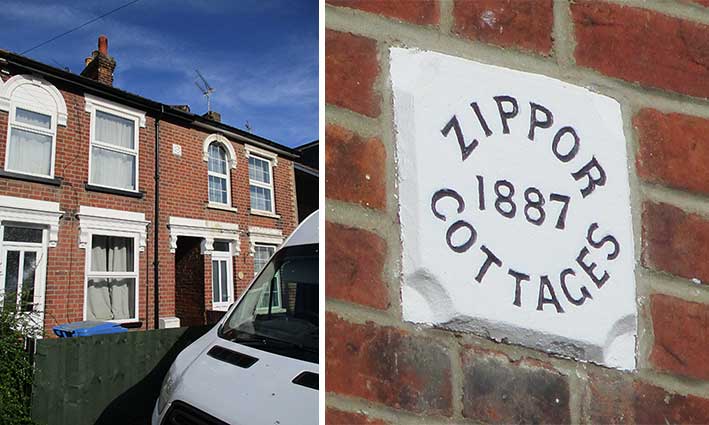 2021 image
2021 image
'ZIPPOR
1887
COTTAGES'
A small square cartouche sits high above the pedimented entrance
to the alleyway between these semi-detached houses in Pearce Road.
'Zippor' is the Hebrew word for bird or sparrow ('that flightiest of
birds') and it appears in the Bible.
St Giles's Terrace, 161-163
Spring Road
 2021 image
2021 image
ST. GILES'S
TERRACE'
This florid lettering poses certain questions: why does 'St'
have an unnecesary full stop (it's a contraction rather than an
abbreviation)?; what is the connection with Saint Giles – we don't have
a church of that dedication in Ipswich?; then there's the annoyance of
the s-apostrophe-s. We see this form of possessive apostrophe in
"Collins's Agency" doorstep mosaic in Norwich Road, on our Serjeant's page.
Gordon Terrace, 14-16 Kemball
Street
 2021 image
2021 image
It is possible that this terrace was named after 'Gordon of
Khartoum', Charles George Gordon (1833-1885), although he died eight
years earlier.

An unsually large tablet bears the legend:
'GORDON
TERRACE
RAYMOND C. WRINCH
A.R.I.B.A. ARCH.T 1903'
It is also unusual to include the
architect's full name, qualification and profession on a modest
Edwardian terrace of seven houses.
See our Museum
Street page for another 'signed'
building by R.C. Wrinch and dated three years later.
Related pages:
House
name plaque examples: Alston Road; Bramford Road;
Cauldwell Hall Road; Cavendish Street; Marlborough Road; Rosehill area; Belle Vue Road;
Ipswich & Suffolk Freehold Land
Society (F.L.S.); California
Street index;
Origins of street names
in Ipswich; Streets named after slavery
abolitionists.
Dated buildings list; Dated buildings examples;
Named
buildings list; Borough
guidelines on street
and house naming and numbering
Street nameplates;
Examples
of Street nameplates (Parliament Road
etc.);
Street furniture; Castings;
Brickyards
; Ropewalks
Home
Please email any comments and contributions by clicking here.
Search Ipswich
Historic Lettering
©2004 Copyright
throughout the Ipswich
Historic Lettering site: Borin Van Loon
No reproduction of text or images without express written permission






 2020
image
2020
image


 2020
images courtesy Paul Smith
2020
images courtesy Paul Smith

 2016
images
2016
images 2013 image
2013 image
 2021
images
2021
images





 2013 image
2013 image




 Photo
courtesy John Norman (2014)
Photo
courtesy John Norman (2014)
 2013
images
2013
images 2019
image
2019
image 2001 image
2001 image
 2013 image
2013 image






 2014 images
2014 images
 2014 images
2014 images



































